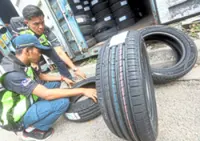Microplastics, much of which is created by tyres when people drive cars, have been found all over the planet, from the bottom of the seas to the placentas of pregnant women. Photo: dpa
Speeding doesn’t only drive up petrol consumption, it also increases tyre wear, and therefore the amount of rubber residue and microplastics you leave behind.
For this reason, frequent drivers in particular should make sure they buy car tyres with low wear.
Already a subscriber? Log in
Save 30% OFF The Star Digital Access
Cancel anytime. Ad-free. Unlimited access with perks.





